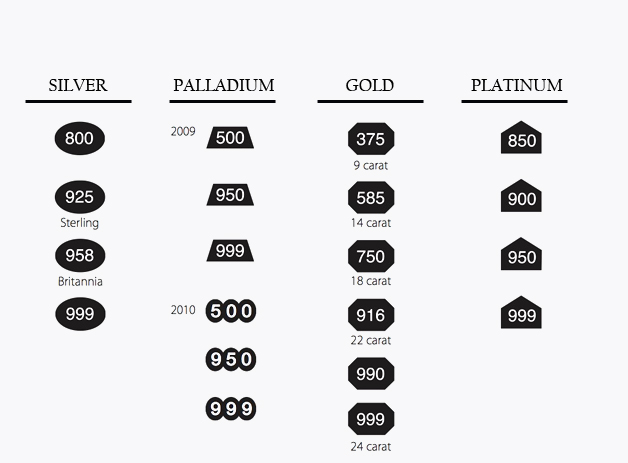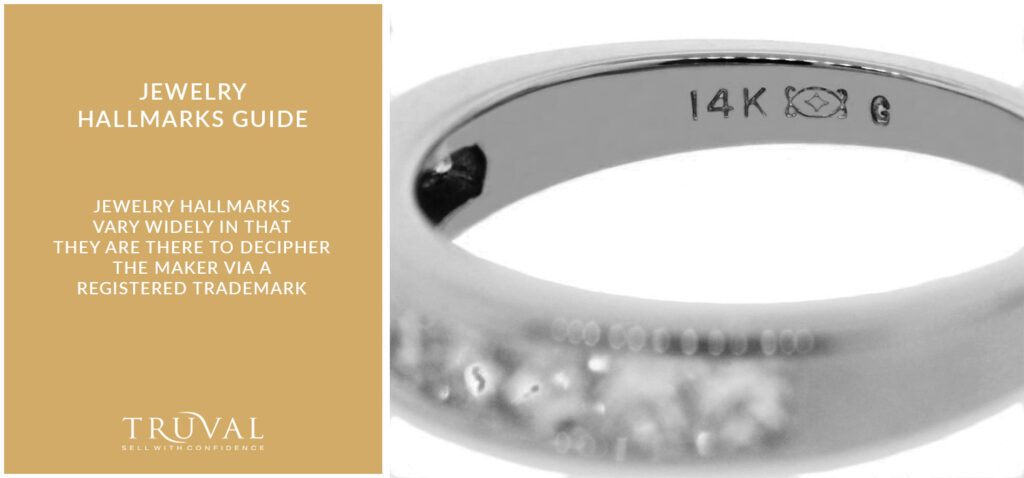The Significance Of Hallmarks In Jewelry: A Comprehensive Guide
The Significance of Hallmarks in Jewelry: A Comprehensive Guide
Related Articles: The Significance of Hallmarks in Jewelry: A Comprehensive Guide
Introduction
With great pleasure, we will explore the intriguing topic related to The Significance of Hallmarks in Jewelry: A Comprehensive Guide. Let’s weave interesting information and offer fresh perspectives to the readers.
Table of Content
- 1 Related Articles: The Significance of Hallmarks in Jewelry: A Comprehensive Guide
- 2 Introduction
- 3 The Significance of Hallmarks in Jewelry: A Comprehensive Guide
- 3.1 The History of Hallmarks: A Journey of Trust and Transparency
- 3.2 Deciphering the Language of Hallmarks: A Guide to Understanding the Marks
- 3.3 The Importance of Hallmarks: A Guarantee of Quality and Authenticity
- 3.4 Hallmarks Around the World: A Global System of Trust and Transparency
- 3.5 FAQs About Hallmarks in Jewelry
- 3.6 Tips for Identifying and Understanding Hallmarks
- 3.7 Conclusion: The Enduring Significance of Hallmarks
- 4 Closure
The Significance of Hallmarks in Jewelry: A Comprehensive Guide

Hallmarks, those small, often inconspicuous marks etched onto jewelry pieces, hold a wealth of information. They are more than just decorative elements; they serve as a vital identifier, providing insight into the origin, composition, and quality of precious metal used in the creation of a piece. Understanding the language of hallmarks is crucial for collectors, buyers, and sellers of jewelry, allowing them to make informed decisions and appreciate the craftsmanship behind their treasured pieces.
The History of Hallmarks: A Journey of Trust and Transparency
The practice of hallmarking can be traced back to medieval Europe. In the 13th century, goldsmiths in London began using distinctive marks to identify their work and ensure the purity of the precious metal used. This system evolved over time, becoming more standardized and regulated. By the 15th century, the practice of hallmarking had spread to other European cities, with each city establishing its own unique set of marks.
The primary purpose of hallmarking was to protect consumers from fraudulent practices. By identifying the maker and the quality of the metal, buyers could be confident that they were acquiring genuine and valuable pieces. Over time, hallmarking also became a way to promote craftsmanship and establish standards within the jewelry industry.
Deciphering the Language of Hallmarks: A Guide to Understanding the Marks
Hallmarks can appear in various forms, including letters, numbers, symbols, or a combination thereof. Each mark carries specific information, which can be deciphered with the right knowledge.
1. Assay Marks: These marks indicate the purity of the precious metal used in the jewelry piece. In most countries, gold is graded according to its fineness, measured in karats (K). The hallmark typically features the karat number, such as 18K, 14K, or 9K, indicating the percentage of pure gold in the alloy.
2. Maker’s Marks: These marks identify the individual or company responsible for crafting the jewelry piece. They can take the form of initials, logos, or other unique symbols. Maker’s marks provide a valuable connection to the history of the piece and can be used to trace its origin and provenance.
3. Town or City Marks: These marks indicate the location where the jewelry was assayed and hallmarked. Each city or town often has its own unique hallmark, which can be used to identify the piece’s geographical origin.
4. Date Marks: These marks indicate the year the jewelry was hallmarked. Date marks can be in the form of letters, numbers, or a combination of both. They are particularly useful for dating antique jewelry pieces.
5. Additional Marks: Some hallmarks may also include additional information, such as a control mark indicating that the piece has been inspected and approved by the assay office, or a special mark indicating that the piece is made from a specific type of gold, such as rose gold or white gold.
The Importance of Hallmarks: A Guarantee of Quality and Authenticity
Hallmarks serve as a vital guarantee of quality and authenticity for jewelry pieces. They provide assurance that the metal used is genuine and meets the standards set by the relevant assay office. By understanding the language of hallmarks, buyers can make informed decisions, knowing that they are acquiring pieces that are not only beautiful but also genuine and valuable.
1. Protection Against Fraud: Hallmarks act as a deterrent against fraudulent practices. By identifying the maker and the quality of the metal, buyers can be confident that they are not purchasing counterfeit or substandard jewelry.
2. Value Enhancement: Authentic hallmarks can significantly enhance the value of a jewelry piece. They provide a verifiable history and a guarantee of quality, which can be particularly important when selling or inheriting jewelry.
3. Historical Significance: Hallmarks offer a fascinating glimpse into the history of jewelry making. They can be used to trace the origins of a piece, identify the maker, and learn about the jewelry industry of a particular time period.
4. Investment Potential: Well-hallmarked jewelry pieces can be considered valuable investments, as they hold their value over time and are often sought after by collectors.
Hallmarks Around the World: A Global System of Trust and Transparency
Hallmarking practices vary across different countries and regions. While the basic principles remain the same, the specific marks and regulations may differ.
1. United Kingdom: The United Kingdom has a long and well-established system of hallmarking, with the London Assay Office being one of the oldest and most reputable in the world.
2. United States: The United States does not have a mandatory hallmarking system for jewelry. However, many jewelers voluntarily hallmark their pieces to indicate the quality and purity of the metal used.
3. Europe: Many European countries have their own hallmarking systems, with the European Union (EU) setting common standards for gold and silver hallmarking.
4. Asia: Countries like Japan and India have their own traditional systems of hallmarking, which often incorporate unique symbols and designs.
FAQs About Hallmarks in Jewelry
1. What are the different types of hallmarking?
There are two main types of hallmarking:
- Assay hallmarking: This type of hallmarking focuses on verifying the purity of the precious metal used.
- Control hallmarking: This type of hallmarking focuses on ensuring that the jewelry piece meets certain standards of craftsmanship and quality.
2. How can I identify a hallmark?
Hallmarks are typically small and inconspicuous marks found on the inside or underside of jewelry pieces. They can be letters, numbers, symbols, or a combination of all three.
3. Where can I find information about hallmarks?
You can find information about hallmarks online, in books, or by contacting a reputable jewelry appraiser or assay office.
4. What if a piece of jewelry does not have a hallmark?
If a piece of jewelry does not have a hallmark, it may be difficult to determine its authenticity and quality. It is always advisable to purchase jewelry from reputable sources and to have any unmarked pieces examined by a qualified appraiser.
5. Are hallmarks always visible?
Hallmarks are not always visible to the naked eye, especially on smaller pieces of jewelry. They may be hidden in a discreet location, such as the inside of a ring band or the back of a pendant.
Tips for Identifying and Understanding Hallmarks
1. Use a magnifying glass: Hallmarks can be quite small, so it is helpful to use a magnifying glass to examine them closely.
2. Research online: There are many websites and online databases that provide information about hallmarks, including images and descriptions of different marks.
3. Consult a professional: If you are unsure about a hallmark, it is always best to consult a reputable jewelry appraiser or assay office.
4. Look for consistency: Hallmarks should be consistent in style and placement on similar pieces of jewelry. If you see inconsistencies, it could be a sign that the piece is not authentic.
5. Be aware of fakes: There are many counterfeit hallmarks in circulation. Be cautious of pieces that have unusual or unfamiliar marks.
Conclusion: The Enduring Significance of Hallmarks
Hallmarks remain an essential element in the world of jewelry, serving as a testament to craftsmanship, quality, and authenticity. By understanding the language of hallmarks, buyers can make informed decisions, ensuring that they are acquiring pieces that are not only beautiful but also genuine and valuable. Whether you are a seasoned collector or a first-time buyer, knowing the significance of hallmarks empowers you to navigate the world of jewelry with confidence and appreciation.








Closure
Thus, we hope this article has provided valuable insights into The Significance of Hallmarks in Jewelry: A Comprehensive Guide. We thank you for taking the time to read this article. See you in our next article!
You may also like
Recent Posts
- The Allure Of Cubic Zirconia: A Comprehensive Guide To Its Beauty And Versatility
- The Evolution Of Jewelry Design: Embracing The Power Of CAD
- Corfe Castle: A Journey Through Time In The English Countryside
- Restoring A Precious Symbol: Repairing A Cut Ring
- A Comprehensive Guide To Silver Jewelry In Chennai: Unveiling The City’s Silver Treasures
- A Glimpse Into Kolkata’s Golden Legacy: Exploring City Gold Jewellery
- Navigating The Landscape Of Charitable Giving: Supporting Local Communities In The Wake Of COVID-19
- Corfe Castle And Village: A Journey Through Time
Leave a Reply